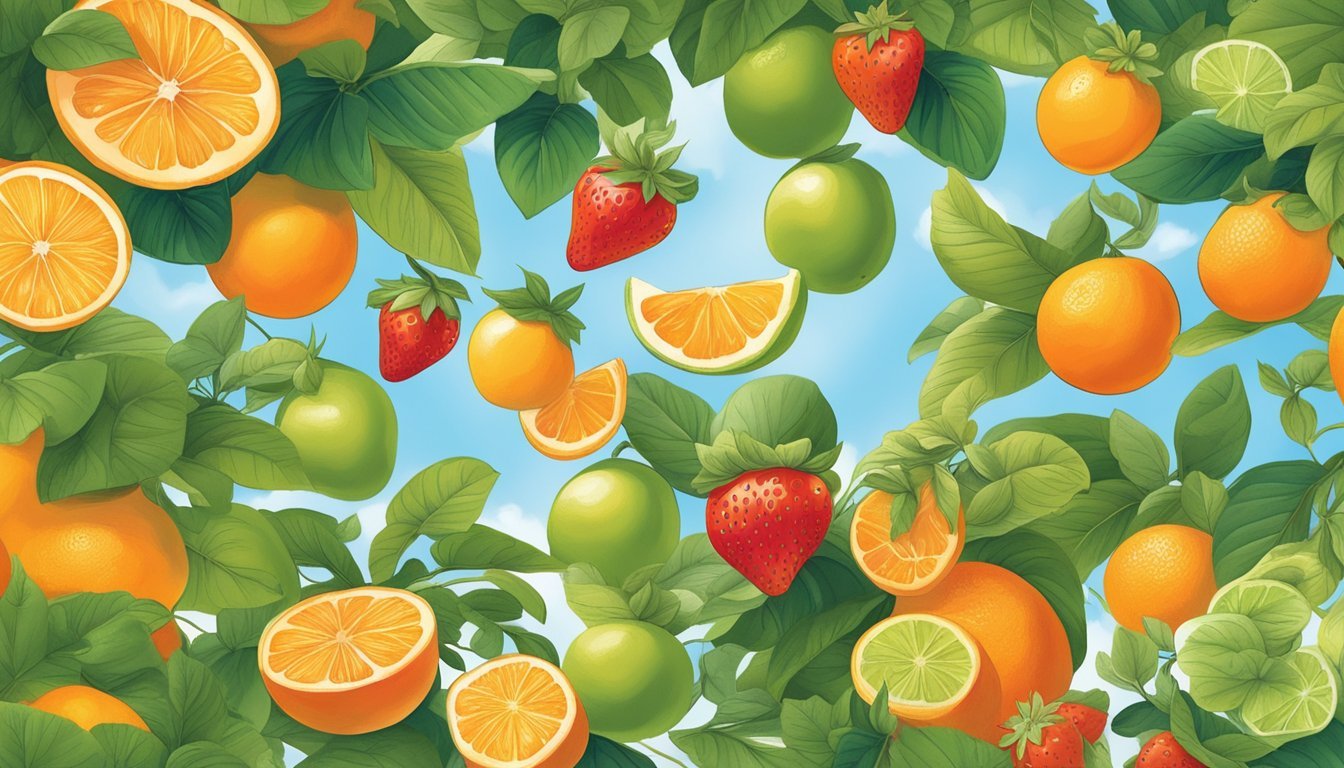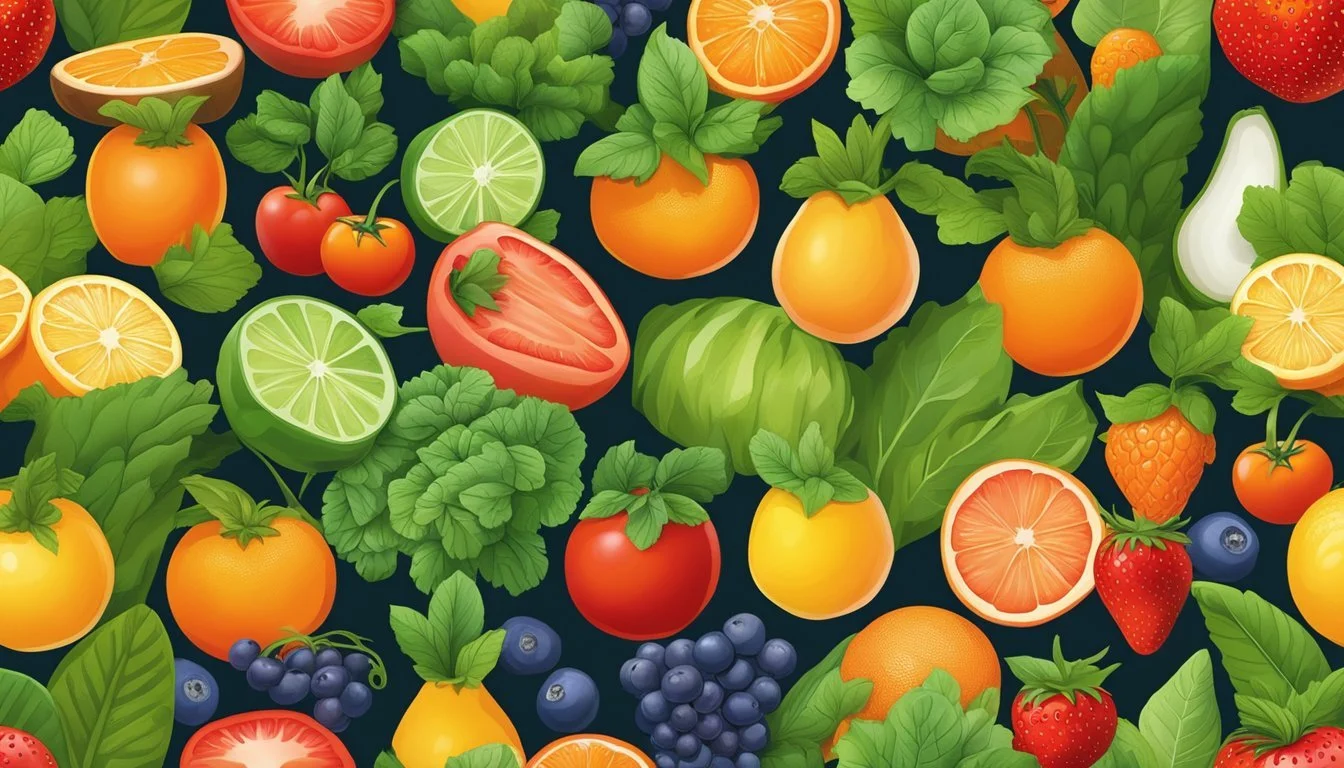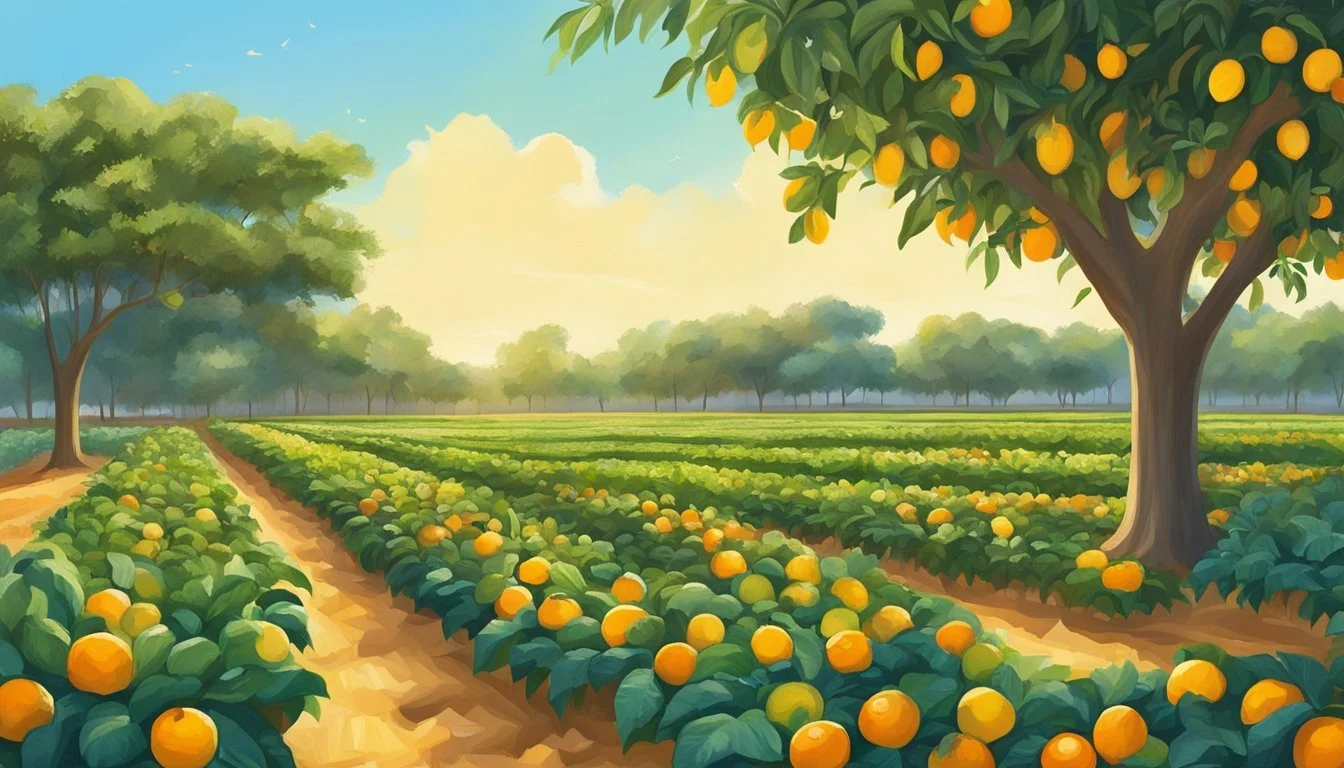Florida Seasonal Fruit & Vegetables in January
A Guide to Fresh Produce Selection
This Article is Part of our Florida Seasonal Fruit & Veg Calendar
In the agricultural tapestry of the United States, Florida stands out for its unique farming calendar, which is greatly influenced by the state's mild winter climate. January in Florida offers an abundance of fresh produce, ensuring that both locals and visitors have access to a variety of fruits and vegetables at their peak freshness. Shoppers and diners can indulge in the vibrant flavors of the season knowing that these food items are not only delicious but also packed with nutritional value due to their freshness.
During this month, Florida's fields and orchards are particularly generous, yielding a diverse range of produce. Vegetables like broccoli (how long does broccoli last?), cabbage, and carrots are harvested in plentiful quantities, offering a fresh, healthy start to the new year. Meanwhile, the citrus season is in full swing, providing a bounty of oranges, grapefruits, and tangerines, which are not only juicy and flavorful but also an excellent source of vitamins during the cooler months. Florida's ability to grow such a wide variety of crops throughout January positions it as a key player in America's winter produce market.
Overview of Florida's Seasonal Produce
In January, Florida's agricultural landscape offers a robust variety of produce, capitalizing on the state's unique climate during the winter months to provide a bounty of fruits and vegetables.
Significance of January for Produce
January is a peak month for many winter crops in Florida. The state's mild winters allow for the harvest of numerous fruits and vegetables that are out of season in much colder regions. During this time, consumers can enjoy fresh, locally-grown produce that includes a range of citrus fruits, leafy greens, and other vegetables.
Fruits typically in season:
Oranges
Tangerines
Grapefruits
Strawberries
Vegetables typically in season:
Tomatoes
Bell peppers
Cucumbers
Broccoli
Climate and Growing Season
Florida's climate is characterized by mild temperatures and a relatively warm winter season, which significantly influences its growing season. In January, while much of the country experiences freezing conditions, Florida's growers benefit from the favorable weather to produce crops that thrive in cooler, but not freezing, temperatures. The diverse climatic zones within Florida, ranging from subtropical in the south to more temperate in the north, contribute to the state's extensive and varied produce offerings during the winter months.
Climatic zones impacting January produce:
Subtropical (South Florida): Aids in the growth of tropical fruits and year-round vegetables.
Temperate (North Florida): Suitable for cool-season crops like cabbages and root vegetables.
Fruits in Season
Florida boasts a diverse range of fresh fruits in the winter month of January, with citrus fruits taking center stage. Tropical fruits continue to flourish, offering their unique flavors, while berries, particularly strawberries, are also available.
Citrus Fruits
January is the prime time for citrus fruits in Florida. The state’s groves are bursting with:
Oranges: Especially the sweet and juicy Navel oranges, are abundantly harvested.
Grapefruit: Known for their slightly tart and refreshing flavor.
Tangerines: A sweeter alternative to oranges and easy to peel.
Lemons and Limes: Essential for their zest and juice, enhancing numerous culinary recipes.
Mandarins: Another sweet citrus variety that is perfect for snacking.
Tropical Fruits
Tropical fruits thrive in Florida's mild winter, with several varieties available:
Guava: This fragrant fruit is versatile in its use, from fresh consumption to jams.
Papaya: Rich in taste and nutrients, often enjoyed in its raw form or in smoothies.
Passion Fruit: Offers a tart flavor and aromatic bouquet, widely used in desserts and drinks.
Bananas: While not as common in commercial production, some local varieties might still be found.
Berries
The berry season begins in winter, with:
Strawberries: They're in peak season, celebrated for their sweetness and enjoyed fresh or in desserts.
The harvest times can vary slightly based on weather conditions and specific regions within the state, but these fruits generally signify the taste of January in Florida.
Vegetables in Season
In January, Florida offers a variety of vegetables that are at their peak of freshness. These vegetables, packed with flavor and nutrients, make them an excellent choice for seasonal eating.
Leafy Greens
January is a prime month for leafy greens in Florida.
Kale and spinach are abundant, known for high levels of vitamins and minerals.
Cabbage is also plentiful, providing a versatile ingredient for warm, comforting dishes.
Lettuce varieties, like romaine and iceberg, remain crisp during this cool month.
Root Vegetables
Florida's root vegetables are particularly sweet and tender in January.
Carrots and radishes bring color and crunch to any plate. They can be enjoyed raw or roasted to bring out their natural sweetness.
Sweet potatoes, with their creamy texture and rich taste, are also a staple, showcasing their versatility in both savory and sweet applications.
Nightshades
While many associate nightshades with summer, some can still be found in January.
Eggplants continue to show up in markets, perfect for hearty stews and roasts.
Inside hot houses, some farmers grow tomatoes, offering a taste of summer even in the winter months, though these are less common.
Florida's January vegetable harvest contributes greatly to a seasonal table, offering variety and flavor that can only come from produce picked at the height of its natural growing season.
Herbs and Other Produce
This section details specific herbs and other produce appropriate for planting in Florida during January, focusing on their varied use and cultivation requirements.
Aromatic Herbs
Basil and thyme are two aromatic herbs ideal for planting in Florida's January climate. Basil thrives in warm temperatures and should be protected from cold snaps. It requires well-drained soil and plenty of sunshine. In contrast, thyme, a hardy herb, can tolerate the cooler temperatures of a Florida winter while still needing adequate sunlight to develop its full flavor profile.
Basil: Full sun, protect from cold weather.
Thyme: Tolerates cool temperatures, requires full sun.
Miscellaneous Crops
January is also a suitable time to consider planting various other crops, such as blueberries, Brussels sprouts (how long do brussels sprouts last?) , leeks, peanuts, pumpkins, and zucchini. These crops have diverse growing conditions but share the commonality of contributing significantly to the seasonal harvest.
Blueberries: Require acidic soil and consistent watering.
Brussels Sprouts: Best planted in a sunny spot with fertile, well-drained soil.
Leeks: Need fertile, well-drained soil along with full sun to partial shade.
Peanuts: Prefer sandy loam soil and require a long, warm growing season.
Pumpkins and Zucchini: Require ample space to grow, full sun exposure, and rich, fertile soil.
Health Benefits of Seasonal Produce
Seasonal fruits and vegetables harvested in Florida during January are packed with essential nutrients. These produce items not only offer enhanced taste but also contribute substantially to a balanced diet.
Nutritional Content
Seasonal produce typically boasts a higher nutrient concentration than out-of-season counterparts transported over long distances. Citrus fruits, for instance, are prevalent during January in Florida and are an excellent source of Vitamin C, which is crucial for immune system function and skin health. Vegetables like kale and broccoli are rich in calcium and potassium, minerals important for bone health and blood pressure regulation, respectively. They also contain antioxidants that help in protecting the body from oxidative stress.
Vitamin C: Found in citrus fruits like oranges and grapefruits.
Potassium: Present in leafy greens such as kale.
Calcium: Abundant in cruciferous vegetables like broccoli.
Antioxidants: Including compounds such as beta-carotene found in various greens.
Freshness and Flavor
Consuming produce in their prime season can yield enhancements in flavor and texture. Fruits and vegetables picked at their peak are often more fragrant and tender, translating to superior taste and culinary experiences. Beta-carotene, an antioxidant and a form of vitamin A, is found in high levels in brightly colored produce such as carrots and sweet potatoes, which can be at their best in January. This nutrient is essential for maintaining healthy vision and immune responses. Fresh, seasonal items may also have a greater likelihood of being grown in optimal conditions, which can influence the development of a fuller flavor profile and nutritional adequacy.
Preparing Seasonal Dishes
January in Florida brings a variety of fresh produce well-suited for both vibrant, raw dishes and comforting, warm meals. The right techniques can highlight their natural flavors and nutritional benefits.
Salads and Raw Preparations
One can celebrate the crunch and freshness of January greens by incorporating them into salads. A classic combination might include thinly sliced cabbage with shredded carrots, dressed with a citrus vinaigrette to enhance the natural flavors. For a tropical twist, slices of ripe carambola (star fruit) can be added to salads for a sweet note, or even served as a snack.
Creating juices and smoothies showcases the full spectrum of Florida's seasonal fruits. Blend a mix of strawberries and carambola for a refreshing juice or integrate them into smoothies for a nutritious breakfast option.
Cooking Techniques for Warm Dishes
Roasting vegetables allows their sugars to caramelize, intensifying their flavor. Broccoli, cut into florets, tossed with olive oil, minced garlic, and a sprinkle of Parmesan cheese, then roasted, transforms into a dish with a deep, savory character ideal for Parmesan roasted broccoli.
For heartier fare, combining seasonal vegetables in a stew or casserole is satisfying. Root vegetables and hardier greens can be simmered slowly to create layers of flavor in soups and stews. A broccoli casserole, enriched with cheese and baked to a golden finish, offers warmth on chilly January evenings.
To conclude, these methods can maximize the fresh flavors of Florida's seasonal produce, providing nourishing and delightful meals reflective of the winter harvest.
Florida's Agricultural Economy
Florida's economy is notably propelled by its vibrant agricultural sector, which includes a diverse array of fresh produce. Two significant entities are central to understanding the state's agricultural success.
Role of the Florida Department of Agriculture
The Florida Department of Agriculture and Consumer Services plays a crucial role in managing Florida's agricultural economy. This department oversees a multitude of tasks ranging from regulatory functions to supporting Florida farmers in marketing their fresh produce. It ensures that both farmers and consumers are adequately informed and protected, facilitating a stable and ethical market environment.
Contribution to Local and State Economy
Agriculture contributes significantly to both the local and state economy in Florida. With the aid of data tracking and regulatory support from the Florida Department of Agriculture, farmers are able to optimize their crop production and distribution. This leads to lucrative outcomes for city and state revenues. It is the vibrant culture of growing and selling fresh produce that bolsters not just the farmers' livelihoods but also adds to the broader economic stability of the state.
Home Gardening Tips
In January, Florida's unique climate zones offer gardeners the opportunity to establish vegetable gardens and maintain fruit trees. Preparation and understanding of seasonal needs are crucial for successful yields.
Starting a Home Vegetable Garden
When starting a vegetable garden in Florida during January, gardeners should select crops suitable for their specific climate zone—North, Central, or South Florida. Soil preparation is key, involving the enrichment with compost or well-rotted manure to provide necessary nutrients. Raised beds or containers can offer excellent drainage and control over soil quality, important for root development and overall plant health.
One should plant vegetables that thrive in Florida's mild winter. Here are suitable crops for this month, grouped by climate zone:
North Florida:
Broccoli
Lettuce
Carrots
Central Florida:
Brussels sprouts
Radishes
Cauliflower (how long does cauliflower last?)
South Florida:
Tomatoes
Peppers
Cucumbers
Water is another consideration; even in the cooler months, regular irrigation may be necessary during dry spells to ensure consistent moisture levels.
Seasonal Fruit Tree Care
Fruit trees in Florida can benefit from care tailored to the winter season. January is typically not a planting month for most fruit trees, but gardeners can focus on maintenance. For existing fruit trees, one should look to prune any dead or diseased branches—this encourages healthy growth come spring.
Fertilization should be minimized or avoided in January since new growth can be harmed by potential frosts. Adding a layer of mulch around the base of fruit trees can provide root insulation and retain soil moisture, both of which are beneficial during cooler months. Regular inspection for pests and diseases allows early intervention, reducing the risk of spread or severe damage.
Shopping for Seasonal Produce
January in Florida offers a variety of fresh produce. Consumers seeking the best in taste and nutrition can find plenty of ripe and plentiful fruits and vegetables influenced by the state's mild winter weather.
Finding Local Farmers' Markets
Local farmers' markets are treasure troves of seasonal produce. Shoppers can discover a wide range of fruits and vegetables that are at their peak. Notable for January, Meyer lemons are often available, offering a sweeter and less acidic flavor than traditional lemons. Here's a list of common Florida produce available in January:
Citrus fruits: Oranges, Tangerines, Grapefruits
Berries: Strawberries
Vegetables: Broccoli, Cabbage, Cauliflower
Leafy Greens: Lettuce, Collard Greens (how long do collard greens last?), Kale
One can locate nearby farmers' markets through local community boards, social media groups, or agriculture department websites.
Identifying Ripe Produce
The ability to identify ripe produce ensures one enjoys fruits and vegetables at their freshest and most flavorful. Some tips for identifying ripe items at the market include:
Color: Bright, uniform coloration is often a good indicator of ripeness.
Texture: For most fruits, a slight give upon gentle pressure suggests ripeness.
Aroma: Ripe fruits, particularly citrus like Meyer lemons, emit a fragrant smell.
It is advisable for shoppers to handle produce gently to prevent bruising. If in doubt, asking the vendor can often yield valuable insights into selecting the best produce.
Seasonal Cycles and Patterns
Florida's climate allows for a variety of fruits and vegetables to be grown throughout the year, with seasonal patterns affecting the availability of different produce. In the winter months, including January, residents enjoy a selection of produce that prefers cooler temperatures.
Winter (December - February) brings in harvests of citrus fruits and leafy vegetables. Even as much of the country is in the deep freeze, Florida's mild weather supports growth of these crops.
During Spring (March - May), the state sees a transition with the introduction of early-season crops like asparagus (how long does asparagus last?). This vegetable begins to appear in the markets typically around late February and March, as the weather starts warming up. Spring also ushers in the beginnings of watermelon season, which peaks in the warmer months.
Summer (June - August) boasts an abundance of fruits, including watermelon, which thrives in the heat. The long, hot days of summer help sweeten this juicy fruit, making it an iconic summer refreshment.
Moving into Fall (September - November), while other regions begin to see a downturn in farming activity, Florida's produce season continues with minimal changes due to its subtropical climate. However, there is a slight shift as fall fruits begin ripening.
Florida does not experience a traditional produce slump, thanks to the year-round growing season. Other states may rely on Florida for their winter produce needs, especially for items like grapefruits and oranges.
Here is a quick overview of some Florida produce and their typical seasons:
Spring: Asparagus, Watermelon (late spring)
Summer: Watermelon
Fall: Transition period, still fruitful
Winter: Citrus fruits (e.g., oranges, grapefruits), Leafy vegetables
While other regions mark April and May as the start of their growing seasons, Florida is already harvesting a variety of fruits and vegetables by this time.
Future Trends in Produce Farming
The agricultural sector is witnessing significant shifts toward sustainability and technological integration. These changes are poised to reshape the landscape of produce farming, particularly in Florida’s fruit and vegetable production.
Sustainable Practices
Farmers are increasingly adopting sustainable farming practices to mitigate environmental impacts and address climate change. Use of organic methods and emphasis on soil health have become more prevalent. For example, cover cropping and reduced-till methods are employed to preserve soil structure and biodiversity. Florida's produce farming is also seeing a trend in water conservation techniques, such as drip irrigation, which ensures that crops receive the right amount of water at the right time, reducing waste.
Technological Advancements
Advancements in technology are streamlining operations and enhancing production efficiency. Data plays a crucial role in these advancements, serving as the backbone for many new farming technologies. For instance, Florida farmers are utilizing precision agriculture tools that gather and analyze data to optimize farming practices. Innovations such as drones and satellite imaging provide detailed insights into crop health, soil conditions, and moisture levels, allowing for precise intervention. These technologies lead to benefits such as:
Improved Yield: By monitoring plant health and soil conditions.
Reduced Costs: Through targeted use of resources.
Enhanced Quality: By enabling farmers to pinpoint the exact time for harvest.
This integration of data-driven technology in Florida's produce farming is not only making agriculture more efficient but is also ensuring that the state remains at the forefront of meeting consumer demands for quality produce.
Resources and References
In crafting an informative guide on Florida's seasonal fruits and vegetables, one should consult a range of reliable sources for the most current and accurate data.
Official Guides and Data
University of Florida's Gardening Solutions: Offers a comprehensive collection of resources for vegetable gardening according to Florida's climate zones, including a monthly planting guide.
Florida Department of Agriculture & Consumer Services: Provides official information on agricultural practices and relevant regulations that affect what is in season.
Culinary Websites and Blogs
Farm Flavor: Shares a Florida produce calendar and offers insights on the optimum times for the freshest produce.
The Spruce Eats: Details a guide on year-round produce availability in Florida, focusing on tropical fruits and vegetables that define the state's unique agricultural offerings.
Conclusion
January in Florida offers an abundance of fresh produce, perfect for starting the year on a healthy note. Vegetables like kale and broccoli thrive, while cauliflower also makes a prominent appearance in markets. Each of these vegetables is packed with essential nutrients, making them ideal for winter wellness.
Citrus fruits, the jewels of Florida's winter, provide a refreshing burst of vitamins, particularly Vitamin C. The availability of fresh citrus allows for a variety of immune-boosting dishes, combining both taste and health benefits.
Below is a quick guide to January produce in Florida:
Vegetables: Kale, Broccoli, Cauliflower, Romanesco
Fruits: Oranges, Lemons
The Florida Department of Agriculture and Consumer Services provides resources for consumers to stay informed about what is locally available. Seasonality charts and local farmers' market directories are valuable tools for those looking to support local agriculture and eat seasonally.
Incorporating January’s seasonal fruits and vegetables into meals not only supports local farmers but also ensures that individuals are consuming some of the freshest and most nutritious produce available. As the season continues, the variety will change, always offering something new to discover in Florida's rich agricultural tapestry.










